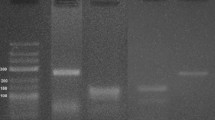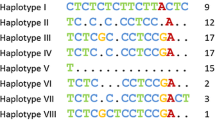Abstract
We developed a simple and reliable method to identify carnivore scats to species using PCR and RFLP of a portion of the mtDNA cytochrome b gene, which works for seven of the most common carnivores in western North America. We identified a short (196 bp) polymorphic region of cytochrome b which would be easily amplifiable even from degraded DNA, developed a primer set, and isolated a set of three restriction enzymes (HpaII, DdeI, HpyCH4V) that would identify the seven target species. In order to test whether this protocol would effectively identify scats obtained in the field we collected 243 carnivore scats from 12 sites in the San Francisco Bay area. Eighty five percent (206) of our samples successfully amplified and were subsequently identified to species using our RFLP protocol. We selected 108 of these samples to sequence; our species identifications based on sequencing were identical to those obtained using our PCR–RFLP method. Our PCR–RFLP method is a simple and efficient means to identify carnivore scats to species, eliminating the need for sequencing, which is costly and requires more laboratory equipment. The technique can also be modified depending on the species present at a particular site. It allows for rapid and noninvasive assessment of multiple carnivore taxa and is particularly useful for surveying populations across many sites.


Similar content being viewed by others
References
DeYoung RW, Honeycutt RL (2005) The molecular toolbox: genetic techniques in wildlife ecology and management. J Wildl Manage 69:1362–1384
Hall TA (1999) BioEdit: a user-friendly biological sequence alignment editor and analysis program for Windows 95/98/NT. Nucleic Acids Symp Ser 41:95–98
Kocher TD, Thomas WK, Meyer A et al (1989) Dynamics of mitochondrial DNA evolution in animals: amplification and sequencing with conserved primers. Proc Nat Acad Sci USA 86:6196–6200
Mills LS, Pilgrim KL, Schwartz MK, McKelvey KS (2000) Identifying lynx and other North American felids based on MtDNA analysis. Conserv Genet 1:285–288
Murphy MA, Waits LP, Kendall KC (2003) The influence of diet on faecal DNA amplification and sex identification in brown bears (Ursus arctos). Mol Ecol 12:2261–2265
Paxinos E, McIntosh C, Ralls K, Fleischer R (1997) A noninvasive method for distinguishing among canid species: amplification and enzyme restriction of DNA from dung. Mol Ecol 6:483–486
Riddle AE, Pilgrim KL, Mills LS, McKelvey KS, Ruggiero LF (2003) Identification of mustelids using mitochondrial DNA and non-invasive sampling. Conserv Genet 4:241–243
Waits LP, Paetkau D (2005) Noninvasive genetic sampling tools for wildlife biologists: a review of applications and recommendations for accurate data collection. J Wildl Manage 69:1419–1433
Acknowledgments
We thank C. Conroy (Museum of Vertebrate Zoology) for providing tissue samples and M. Rew for sequencing assistance. Thanks to A. Merenlender for helpful comments on the manuscript. This study was supported by an American Society of Mammalogists Grant-in-Aid of Research (ALB) and a NSF Graduate Research Fellowship, Budweiser Conservation Scholarship, Phi Beta Kappa Doctoral Fellowship and a Berkeley Sigma Xi Grant-in-Aid of Research (SER).
Author information
Authors and Affiliations
Corresponding author
Rights and permissions
About this article
Cite this article
Bidlack, A.L., Reed, S.E., Palsbøll, P.J. et al. Characterization of a western North American carnivore community using PCR–RFLP of cytochrome b obtained from fecal samples. Conserv Genet 8, 1511–1513 (2007). https://doi.org/10.1007/s10592-007-9285-3
Received:
Accepted:
Published:
Issue Date:
DOI: https://doi.org/10.1007/s10592-007-9285-3




